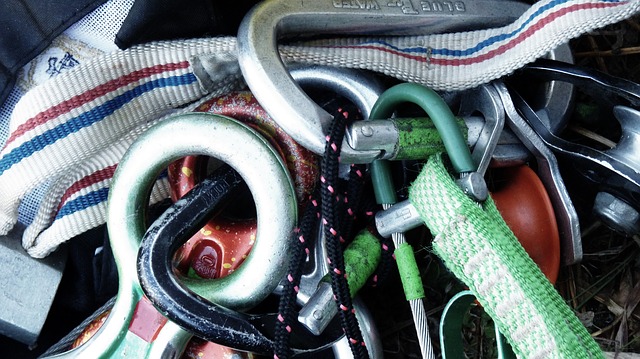
Rocky climbing is a worthwhile pursuit whether you’re looking for fun, fitness, or a healthy dose of adrenaline. It’s an outdoor sport that attracts a fair share of daredevils, but there are plenty of everyday people who enjoy rock climbing adventures too.
It doesn’t take a lot to become a rock jock, but you need to be reasonably fit, get some instruction, and have the proper equipment.
Most of the equipment will be provided if you start with rock climbing classes, but when you’re proficient and ready to head out on your own, make sure you’ve got the following rock climbing equipment.
Climbing Ropes
Climbing ropes are essential unless you’re bouldering (climbing no more than around 15 feet with a crashmat for safety) or free soloing (which only a few of the most experienced climbers do).
For everyone else, you need climbing ropes to use with your harness, carabiners, belay device, quickdraw, and cams. They will save your life should you slip or fall off the rock face.
Consider the following when buying your ropes:
- Rope type
- Diameter
- Length
- Rope features
- Safety ratings
Harness
The two most important things to consider are how much you want to spend and what type of climbing you plan to do.
A typical harness has two front tie-in points where you thread the rope and tie it on. One point is at the waist, and the other is at the leg loops. You fasten the harness around your waist using the waist belt.
A catch-all harness will serve you well in various climbing disciplines, with comfort and versatility being your primary focus.
The ideal harness is comfortable to wear with your clothing. It should also allow for a full range of movement. Key features to look for include:
- Padding
- Extra-wide webbing
- Ventilation
- Moisture transport
Belay Device
A belay device is a mechanical friction brake that will protect you from falls, and you can use it to lower yourself from an ascent. There are three types of belay devices to choose from, depending on the type of climbing you want to do: tubular, assisted-breaking, and figure 8.
Carabiners
Carabiners are used for many different things, such as connecting climbing ropes with other equipment such as nuts, bolts, and camming devices.
You can attach items to a carabiner without worrying about them becoming detached. They are generally made from steel and will be rigorously tested for strength. A gate allows you to pass a rope or equipment through them, and then it shuts to stop the equipment from coming loose.
There are several different carabiners, such as wire carabiners, straight gate carabiners, and locking carabiners.
Quickdraws
A quickdraw is made from two carabiners connected by a textile sling. One end is attached to a bolt hanger, and the other to a rope. This provides slack on the rope and allows the rope to move around while staying connected to the bolt hanger.
Climbing Cams
Climbing cams, also known as spring-loaded camming devices (SLCDs), fit into gaps and cracks in the rocks. They grip and provide protection. Cams are an alternative to using a nut or bolt and offer more flexibility when choosing a route up a rock face.
A cam is a non-invasive form of climbing protection because it doesn’t damage the rock. Instead, they work by spreading apart the harder you pull, thereby gripping the walls of the crack you’ve placed them in.
Climbing Helmet
A helmet is a crucial piece of rock climbing equipment because it protects you from fracturing rock faces, falling stones, rocks, and sometimes even boulders. Some climbing helmets are also designed to protect in the event of a fall. However, not all of them do, so make sure you check before purchasing.
The best helmet fits snugly and sits flat on your head. It shouldn’t feel too tight or obstruct your line of sight up the rock face or climbing wall.
Climbing Shoes
Climbing shoes are tight-fitting, made from thin material, and have a rubber sole and outer edges. Their design ensures your foot has the best grip on the wall and allows you to stand on holds that you wouldn’t be able to barefoot or in regular shoes.
Climbing shoes are most often categorized by skill level. Beginner shoes are relatively flat. Intermediate shoes tend to be slightly arched. Finally, advanced shoes are arched even more.
Chalk Bag and Chalk
You use chalk to increase your grip and friction on the surface of your hand as it dries sweat and other moisture. Any climbing chalk will do the job, but smaller grained chalk is better because it’s less hassle to break up.
You use a chalk bag for storing your chalk. Typically they are a small synthetic or canvas bag with an opening that comfortably fits your whole hand. A cylindrical bag is ideal for long climbs, whereas a tapered bag is better for shorter routes.
Climbing Tape
Climbing tape is used to protect your hands and fingers from developing flappers, the tears on the pads on your fingers that form when your hands slip off a hold. In addition, some climbing tapes contain zinc-oxide that helps heal any abrasions.
Some climbers also use tape to strengthen their fingers and provide support for the small muscles and tendons.
Crash Mat
A crash mat is essential if you’re going to be bouldering. It is the only thing between you and the hard floor.
Rock climbing is an exhilarating pastime, but only if you’ve got the right equipment.





